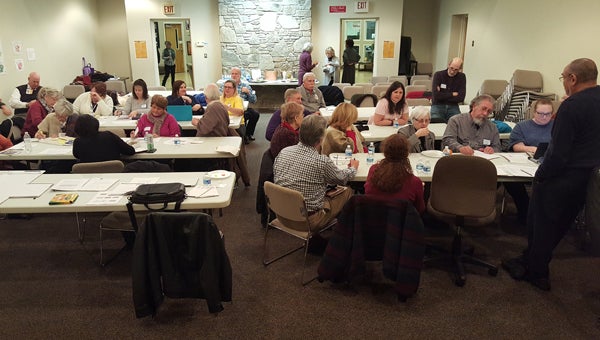Health forum looks at community data on obesity, exercise, tobacco, mental health
Published 10:00 pm Wednesday, January 20, 2016

Members of the community gathered at Isothermal Community College campus in Columbus Tuesday evening to listen to Rutherford Polk McDowell Health District’s Public Health Consultant Marjorie Vestal break down statistics from the 2015 Community Health Assessment conducted in May 2015. Attendees then convened in smaller groups based on different categories outlined in the presentation to discuss solutions for Polk County with regards to the health of the county’s residents. The three main categories discussed included tobacco, healthy eating and active living, and the social determinants of health for the area. (Photo by Michael O’Hearn)
By Michael O’Hearn
michael.ohearn@tryondailybulletin.com
Vestal outlined the purpose of the 2015 health assessment as describing the health status of the community. A survey of 200 Polk County residents was used to create the data presented at the forum. Based on Vestal’s results, a number of health priorities were created for 2016 through 2019.
Beginning with population and the life expectancy of individuals, the data collected showed the median age of individuals in Polk County is 49.1 years, which is 4.4 years older, as Vestal put it, than the average for Western North Carolina and 11.1 years older than the state average.
Life expectancy is 80.2 years for those born between 2011 and 2013, higher than Western North Carolina and North Carolina averages.
Hispanics have also seen a higher birth rate compared to other racial groups. However, birth rates have fallen between 2006 and 2013 among Hispanics, whites and African Americans overall.
The ages of the elderly, between 75 and 84 years old, will see an increase of 59 percent and those older than 85 will also see an increase of 21 percent between 2010-2030.
During the survey in May, Vestal reported that 16 percent of the 200 participants she interviewed said “they had more than seven days of poor mental health in the past month.” This is an increase of 4.2 percent three years prior in 2012, with the Western North Carolina percentage clocking in at 15 percent in 2015.
Additionally, 17.2 percent of people experienced “fair” or “poor” overall health in 2015 in Western North Carolina. Compare this number to 23.2 percent in 2012 and it is an improvement in this category.
The statistic for people without health insurance has risen from 10.4 percent to 11.2 percent for those between the ages of 0 and 18. An increase of 22.9 to 25.0 percent was noted for individuals between 18 and 64 years of age. This is lower than Western North Carolina as a whole between 2009 and 2013.
Tobacco, births by mothers who smoked during their pregnancies, and secondhand smoke were also covered in Vestal’s PowerPoint.
More people have reported they are overweight or obese, according to the health assessment. This statistic has risen 3.1 percent in Polk County from 60.6 percent in 2012 to 65.6 percent in 2015.
Exercise is a factor analyzed in the data, and Vestal and the health department concluded that 25.7 percent of people did not get any leisure-time physical activity during the last month when the survey was conducted in May.
Vestal stated 23.7 percent of respondents relate their lack of activity to back and neck problems, higher than the WNC statistic of 18.6 percent.
Four break out groups then were each given a category to discuss revolving around the data presented by Vestal.
Ben Ellington, a member of the Polk Fit, Fresh and Friendly group, addressed the issue of availability of social and emotional help.
“There’s a need to develop communication strengths, to inform people about the services the county provides,” Ellington said.
Marilyn Kaylor, a representative of the Smoky Mountain Center for Mental Health, Developmental Disabilities and Substance Abuse Services, took the stage to serve as a spokesperson for her group.
“There needs to be education around these stigmas and discriminations,” Kaylor said. “We also need to bring forth mental health awareness into schools early. We are able to collaborate with each other and with providers and show that airways are open.”
Jimmi Buell, also with Polk Fit, Fresh and Friendly, stepped forth on behalf of the healthy eating and active living community members in attendance at the forum.
“Fresh fruits and vegetables need to be introduced. There should also be a ‘no soft drinks’ campaign outside of the schools, because the schools already aren’t allowed soft drinks,” Buell said. “Targeting new moms, having low cost meals and assessing why people aren’t eating healthy should be a solution. We also should increase the total acreage of community gardens and get schools to offer healthier options.”
Free activities such as yoga, walking activities and clubs for these activities were proposed by Buell and her group.
Vestal concluded the meeting with her group of tobacco and substance abuse community leaders by bringing up the points of cessation and prevention.
“Beginning to make connections with school systems, government and key leaders for successful interventions would be good,” Vestal explained to the audience. “Training and education about the costs of tobacco, including the surcharge on insurance from 150 to 200 percent if you’re a smoker, would reduce barriers to extending cessation training at convenient locations.”





